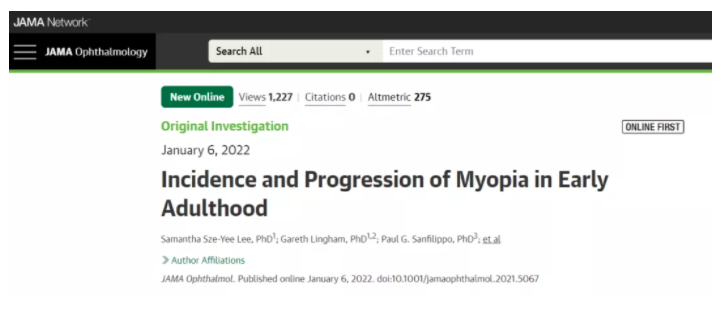The following article comes from the new viewpoint of medicine, and the author is from the new viewpoint of medicine
Wuxi apptec content team editor
At present, myopia has become a major public health problem affecting Chinese eye health. Myopia is a kind of ametropia in which the light parallel to the optic axis enters the eye and focuses in front of the retina in a relaxed state of adjustment. This is usually caused by the long distance between the front and back of the eye, the excessive bending of the cornea and the excessive refraction of the lens.
Generally, close work or study (< 33cm), poor reading and writing habits, insufficient daylighting or lighting, lack of nutrition and sleep time are considered to be the risk factors affecting the occurrence and development of myopia. In recent years, myopia is particularly high among teenagers. Will myopia increase in adulthood?

Screenshot source: JAMA ophthalmology
Recently, a study published in JAMA ophthalmology found that the probability of myopia in adulthood was 14%, and the probability of high myopia was 0.7%.
A total of 813 20-year-old young people were included in this prospective cohort study. These participants did not include people who had keratoconus, had previous corneal surgery, or recently wore corneal shaping glasses. All participants underwent ophthalmic examination before the start of the trial (20 years old) and after 8 years of follow-up (28 years old). The main outcomes and indicators were the incidence of myopia and high myopia, the changes of equivalent spherical endoscopy (SE) and ocular axis (AL) during the follow-up period.
A total of 1328 participants participated in the baseline evaluation at the beginning of the trial. After 8 years of follow-up, two follow-up information of 701 participants was available. Finally, participants included in the incidence analysis included those without myopia at the beginning of the trial (516) and those without high myopia at the beginning of the trial (698).
After 8 years of follow-up, the researchers observed that participants:
The incidence of myopia was 14%;
The incidence of high myopia was 0.7%;
37.8% (261 people) had myopia drift (diopter of at least one eye was 0.50);
The equivalent spherical mirror (which converts astigmatism into a spherical mirror with similar optical effect) increased by an average of 0.04 diopter per year (P < 0.001);
The length of ocular axis increased by 0.02 mm per year (P < 0.001);
The average annual increase of lens thickness (thickening and myopia) was 0.02 mm (P < 0.001).
The overall research data may be related to the nationality, gender and parents' myopia of the participants; However, educational level had no relationship with the incidence or progression of myopia. Specifically:
The risk of myopia in women was 81% higher than that in men (or = 1.81, P = 0.04). The progression of myopia and axial elongation were faster in women;
The risk of myopia in East Asians was about 5 times higher than that in Caucasians (or = 6.13, P = 0.04);
Participants with parental myopia had a 57% higher risk of myopia (or = 1.57, P = < 0.05).
In addition, people who receive less sunlight have a much higher risk of myopia. This is reflected in that the risk of myopia increases nearly 9 times for every 10 mm2 reduction in conjunctival ultraviolet autofluorescence area (or = 9.86, P = <. 009).
The conclusion is that more than 1/3 of adults will continue to progress at 20-30 years of age, and the incidence rate of myopia and myopia are higher, although the rate of progression is lower than that of childhood. The protective effect of outdoor time on myopia may last until youth.
reference material
[1] Lee SS, Lingham G, Sanfilippo PG, et al. (2022). Incidence and Progression of Myopia in Early Adulthood. JAMA Ophthalmol, doi:10.1001/jamaophthalmol. two thousand and twenty-one point five zero six seven
Disclaimer: Wuxi apptec content team focuses on introducing the progress of global biomedical health research. This article is only for the purpose of information exchange. The views in this article do not represent the position of Yao Ming Kant, nor does it represent that Yao Ming Kant supports or opposes the views in this article. This article is not a treatment recommendation. For treatment plan guidance, please go to a regular hospital.